Fundamentals of Finance Assignment
VerifiedAdded on 2020/03/16
|7
|966
|36
AI Summary
Contribute Materials
Your contribution can guide someone’s learning journey. Share your
documents today.
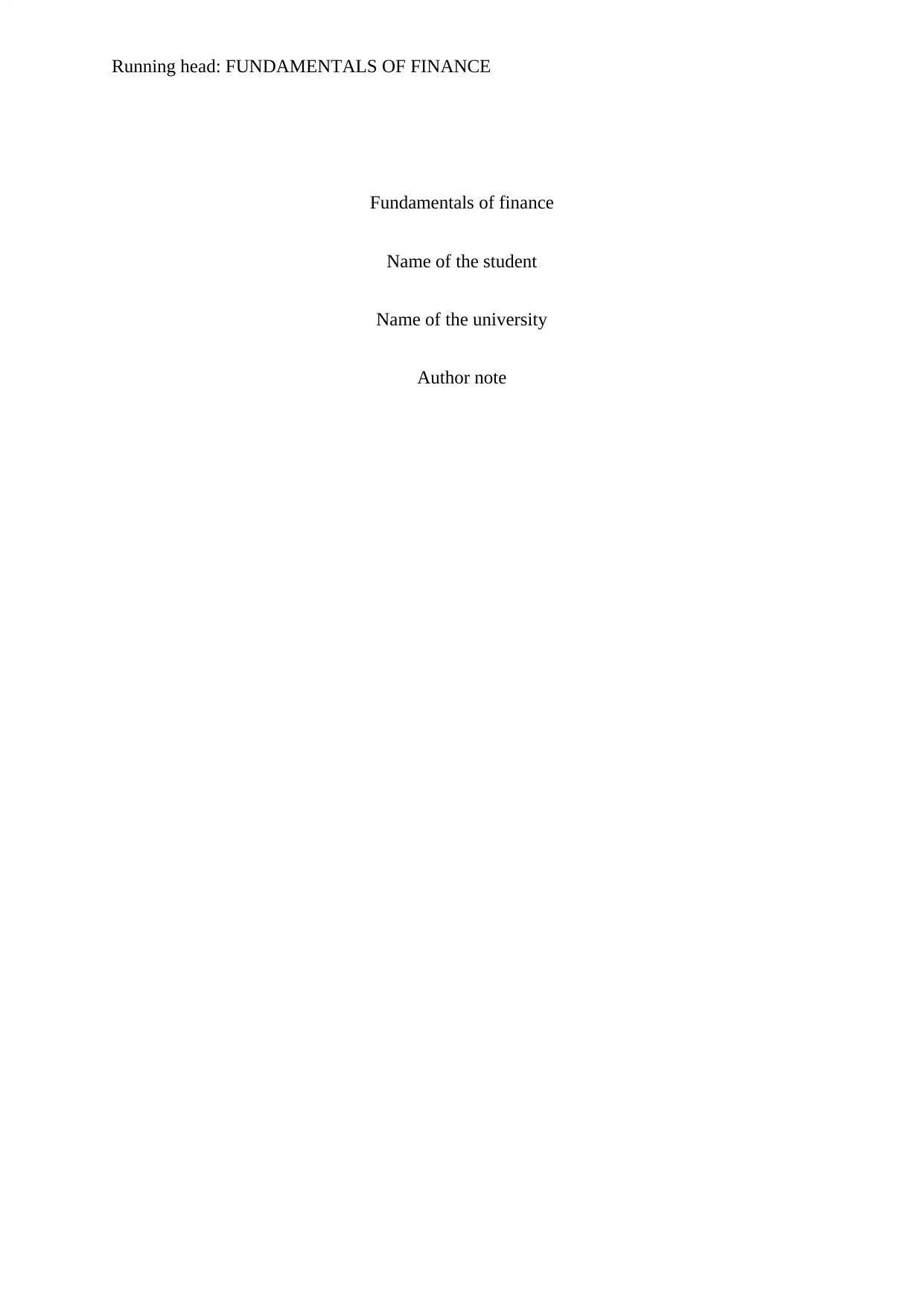
Running head: FUNDAMENTALS OF FINANCE
Fundamentals of finance
Name of the student
Name of the university
Author note
Fundamentals of finance
Name of the student
Name of the university
Author note
Secure Best Marks with AI Grader
Need help grading? Try our AI Grader for instant feedback on your assignments.
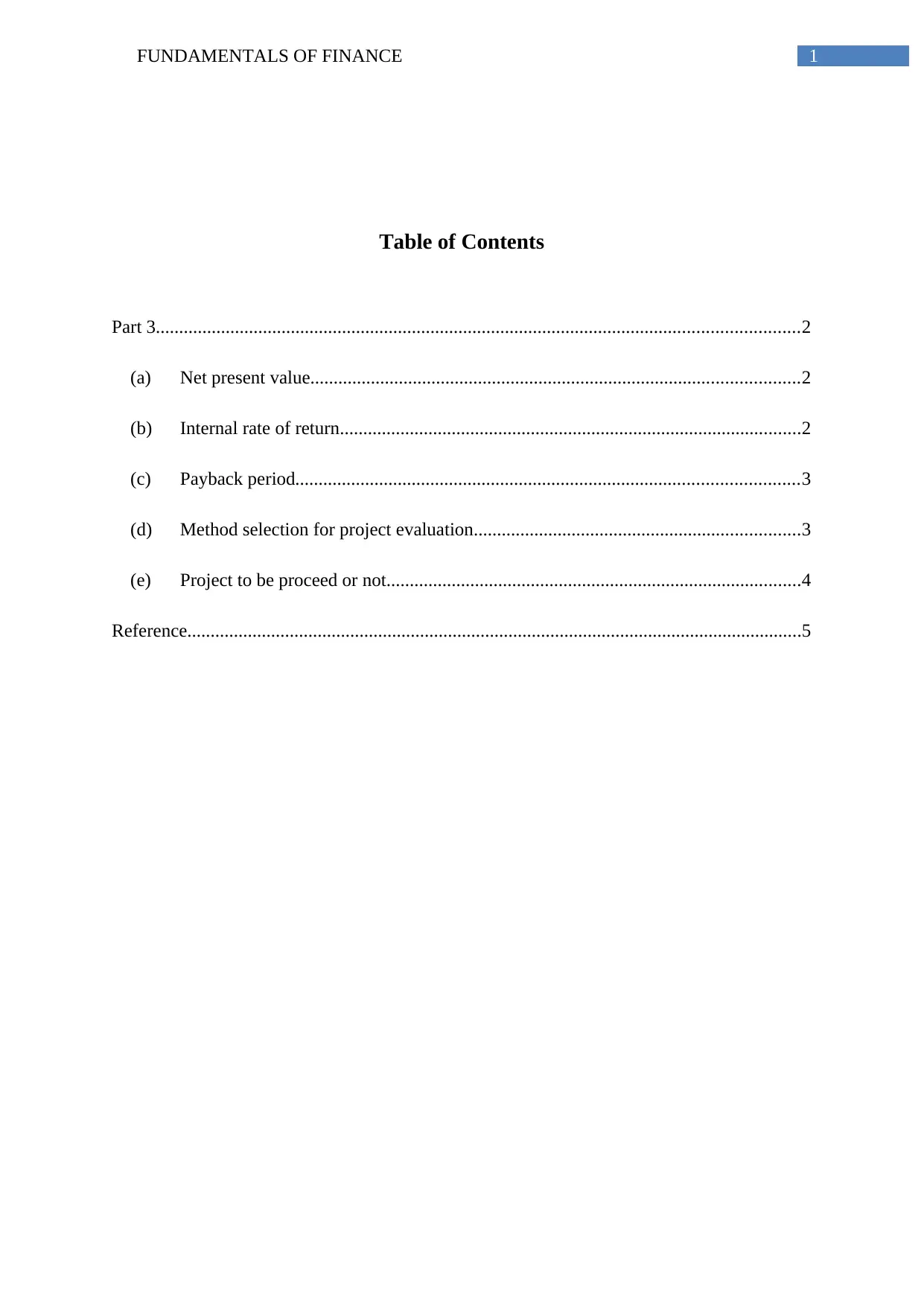
1FUNDAMENTALS OF FINANCE
Table of Contents
Part 3..........................................................................................................................................2
(a) Net present value.........................................................................................................2
(b) Internal rate of return...................................................................................................2
(c) Payback period............................................................................................................3
(d) Method selection for project evaluation......................................................................3
(e) Project to be proceed or not.........................................................................................4
Reference....................................................................................................................................5
Table of Contents
Part 3..........................................................................................................................................2
(a) Net present value.........................................................................................................2
(b) Internal rate of return...................................................................................................2
(c) Payback period............................................................................................................3
(d) Method selection for project evaluation......................................................................3
(e) Project to be proceed or not.........................................................................................4
Reference....................................................................................................................................5
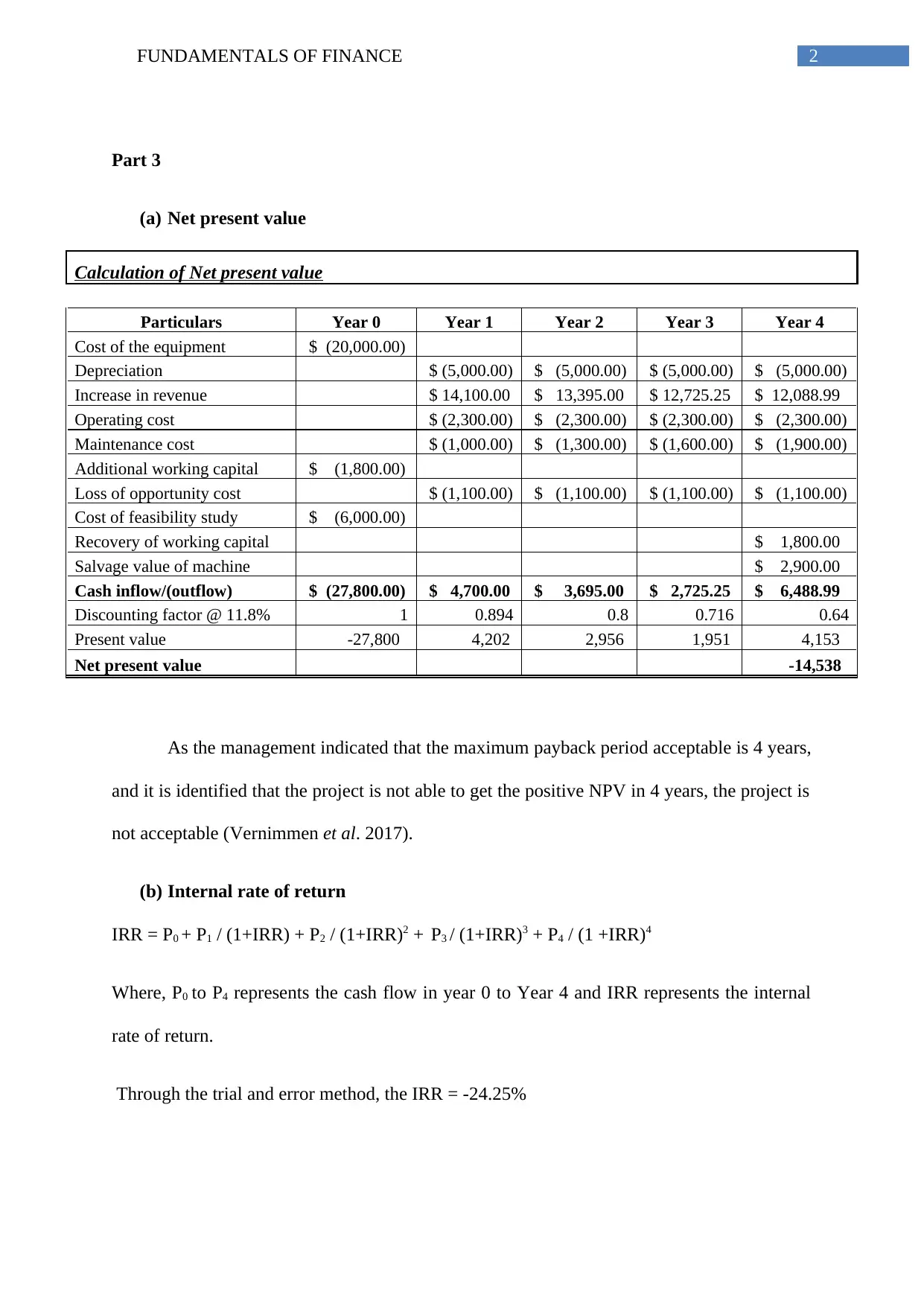
2FUNDAMENTALS OF FINANCE
Part 3
(a) Net present value
Calculation of Net present value
Particulars Year 0 Year 1 Year 2 Year 3 Year 4
Cost of the equipment $ (20,000.00)
Depreciation $ (5,000.00) $ (5,000.00) $ (5,000.00) $ (5,000.00)
Increase in revenue $ 14,100.00 $ 13,395.00 $ 12,725.25 $ 12,088.99
Operating cost $ (2,300.00) $ (2,300.00) $ (2,300.00) $ (2,300.00)
Maintenance cost $ (1,000.00) $ (1,300.00) $ (1,600.00) $ (1,900.00)
Additional working capital $ (1,800.00)
Loss of opportunity cost $ (1,100.00) $ (1,100.00) $ (1,100.00) $ (1,100.00)
Cost of feasibility study $ (6,000.00)
Recovery of working capital $ 1,800.00
Salvage value of machine $ 2,900.00
Cash inflow/(outflow) $ (27,800.00) $ 4,700.00 $ 3,695.00 $ 2,725.25 $ 6,488.99
Discounting factor @ 11.8% 1 0.894 0.8 0.716 0.64
Present value -27,800 4,202 2,956 1,951 4,153
Net present value -14,538
As the management indicated that the maximum payback period acceptable is 4 years,
and it is identified that the project is not able to get the positive NPV in 4 years, the project is
not acceptable (Vernimmen et al. 2017).
(b) Internal rate of return
IRR = P0 + P1 / (1+IRR) + P2 / (1+IRR)2 + P3 / (1+IRR)3 + P4 / (1 +IRR)4
Where, P0 to P4 represents the cash flow in year 0 to Year 4 and IRR represents the internal
rate of return.
Through the trial and error method, the IRR = -24.25%
Part 3
(a) Net present value
Calculation of Net present value
Particulars Year 0 Year 1 Year 2 Year 3 Year 4
Cost of the equipment $ (20,000.00)
Depreciation $ (5,000.00) $ (5,000.00) $ (5,000.00) $ (5,000.00)
Increase in revenue $ 14,100.00 $ 13,395.00 $ 12,725.25 $ 12,088.99
Operating cost $ (2,300.00) $ (2,300.00) $ (2,300.00) $ (2,300.00)
Maintenance cost $ (1,000.00) $ (1,300.00) $ (1,600.00) $ (1,900.00)
Additional working capital $ (1,800.00)
Loss of opportunity cost $ (1,100.00) $ (1,100.00) $ (1,100.00) $ (1,100.00)
Cost of feasibility study $ (6,000.00)
Recovery of working capital $ 1,800.00
Salvage value of machine $ 2,900.00
Cash inflow/(outflow) $ (27,800.00) $ 4,700.00 $ 3,695.00 $ 2,725.25 $ 6,488.99
Discounting factor @ 11.8% 1 0.894 0.8 0.716 0.64
Present value -27,800 4,202 2,956 1,951 4,153
Net present value -14,538
As the management indicated that the maximum payback period acceptable is 4 years,
and it is identified that the project is not able to get the positive NPV in 4 years, the project is
not acceptable (Vernimmen et al. 2017).
(b) Internal rate of return
IRR = P0 + P1 / (1+IRR) + P2 / (1+IRR)2 + P3 / (1+IRR)3 + P4 / (1 +IRR)4
Where, P0 to P4 represents the cash flow in year 0 to Year 4 and IRR represents the internal
rate of return.
Through the trial and error method, the IRR = -24.25%
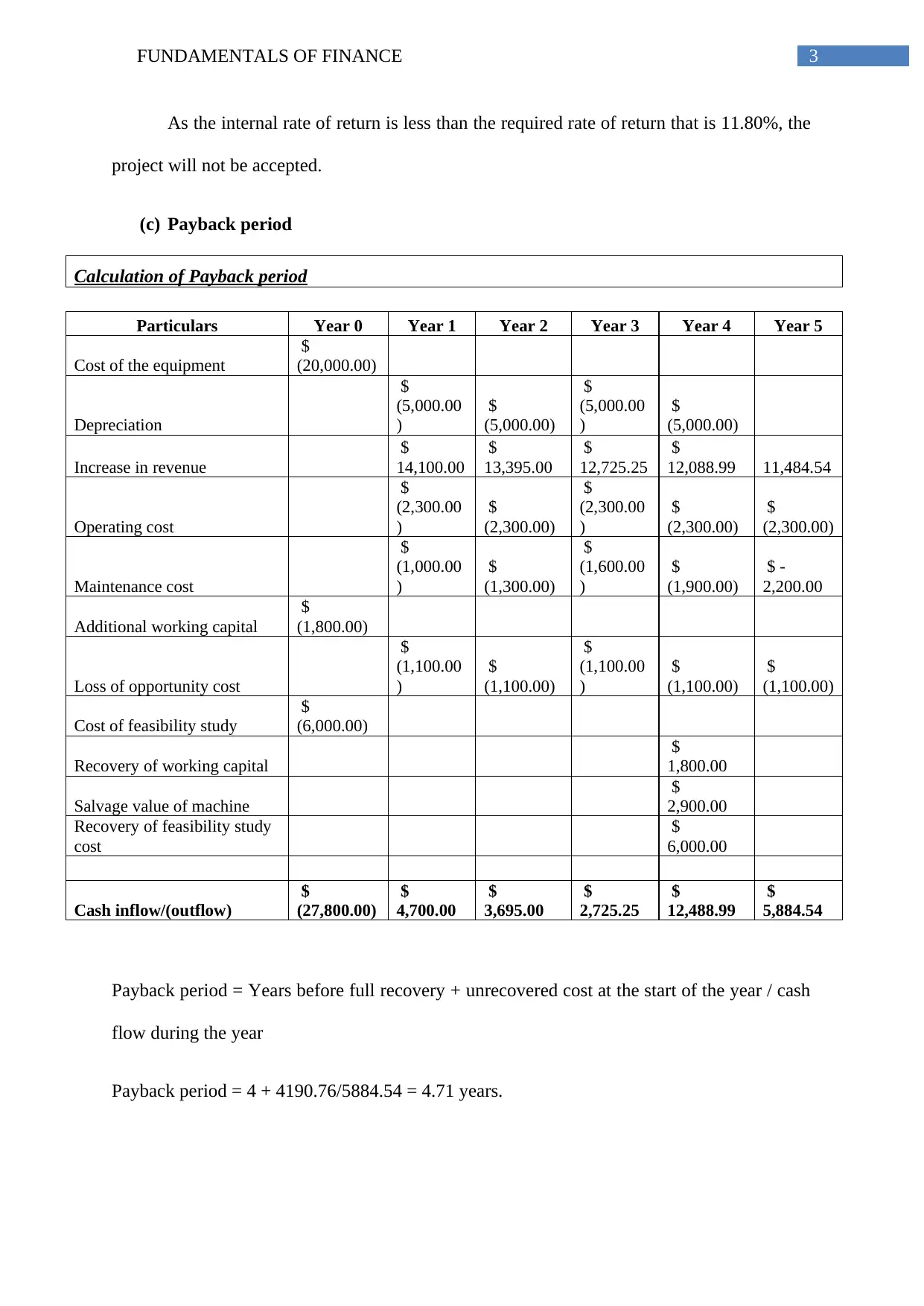
3FUNDAMENTALS OF FINANCE
As the internal rate of return is less than the required rate of return that is 11.80%, the
project will not be accepted.
(c) Payback period
Calculation of Payback period
Particulars Year 0 Year 1 Year 2 Year 3 Year 4 Year 5
Cost of the equipment
$
(20,000.00)
Depreciation
$
(5,000.00
)
$
(5,000.00)
$
(5,000.00
)
$
(5,000.00)
Increase in revenue
$
14,100.00
$
13,395.00
$
12,725.25
$
12,088.99 11,484.54
Operating cost
$
(2,300.00
)
$
(2,300.00)
$
(2,300.00
)
$
(2,300.00)
$
(2,300.00)
Maintenance cost
$
(1,000.00
)
$
(1,300.00)
$
(1,600.00
)
$
(1,900.00)
$ -
2,200.00
Additional working capital
$
(1,800.00)
Loss of opportunity cost
$
(1,100.00
)
$
(1,100.00)
$
(1,100.00
)
$
(1,100.00)
$
(1,100.00)
Cost of feasibility study
$
(6,000.00)
Recovery of working capital
$
1,800.00
Salvage value of machine
$
2,900.00
Recovery of feasibility study
cost
$
6,000.00
Cash inflow/(outflow)
$
(27,800.00)
$
4,700.00
$
3,695.00
$
2,725.25
$
12,488.99
$
5,884.54
Payback period = Years before full recovery + unrecovered cost at the start of the year / cash
flow during the year
Payback period = 4 + 4190.76/5884.54 = 4.71 years.
As the internal rate of return is less than the required rate of return that is 11.80%, the
project will not be accepted.
(c) Payback period
Calculation of Payback period
Particulars Year 0 Year 1 Year 2 Year 3 Year 4 Year 5
Cost of the equipment
$
(20,000.00)
Depreciation
$
(5,000.00
)
$
(5,000.00)
$
(5,000.00
)
$
(5,000.00)
Increase in revenue
$
14,100.00
$
13,395.00
$
12,725.25
$
12,088.99 11,484.54
Operating cost
$
(2,300.00
)
$
(2,300.00)
$
(2,300.00
)
$
(2,300.00)
$
(2,300.00)
Maintenance cost
$
(1,000.00
)
$
(1,300.00)
$
(1,600.00
)
$
(1,900.00)
$ -
2,200.00
Additional working capital
$
(1,800.00)
Loss of opportunity cost
$
(1,100.00
)
$
(1,100.00)
$
(1,100.00
)
$
(1,100.00)
$
(1,100.00)
Cost of feasibility study
$
(6,000.00)
Recovery of working capital
$
1,800.00
Salvage value of machine
$
2,900.00
Recovery of feasibility study
cost
$
6,000.00
Cash inflow/(outflow)
$
(27,800.00)
$
4,700.00
$
3,695.00
$
2,725.25
$
12,488.99
$
5,884.54
Payback period = Years before full recovery + unrecovered cost at the start of the year / cash
flow during the year
Payback period = 4 + 4190.76/5884.54 = 4.71 years.
Secure Best Marks with AI Grader
Need help grading? Try our AI Grader for instant feedback on your assignments.
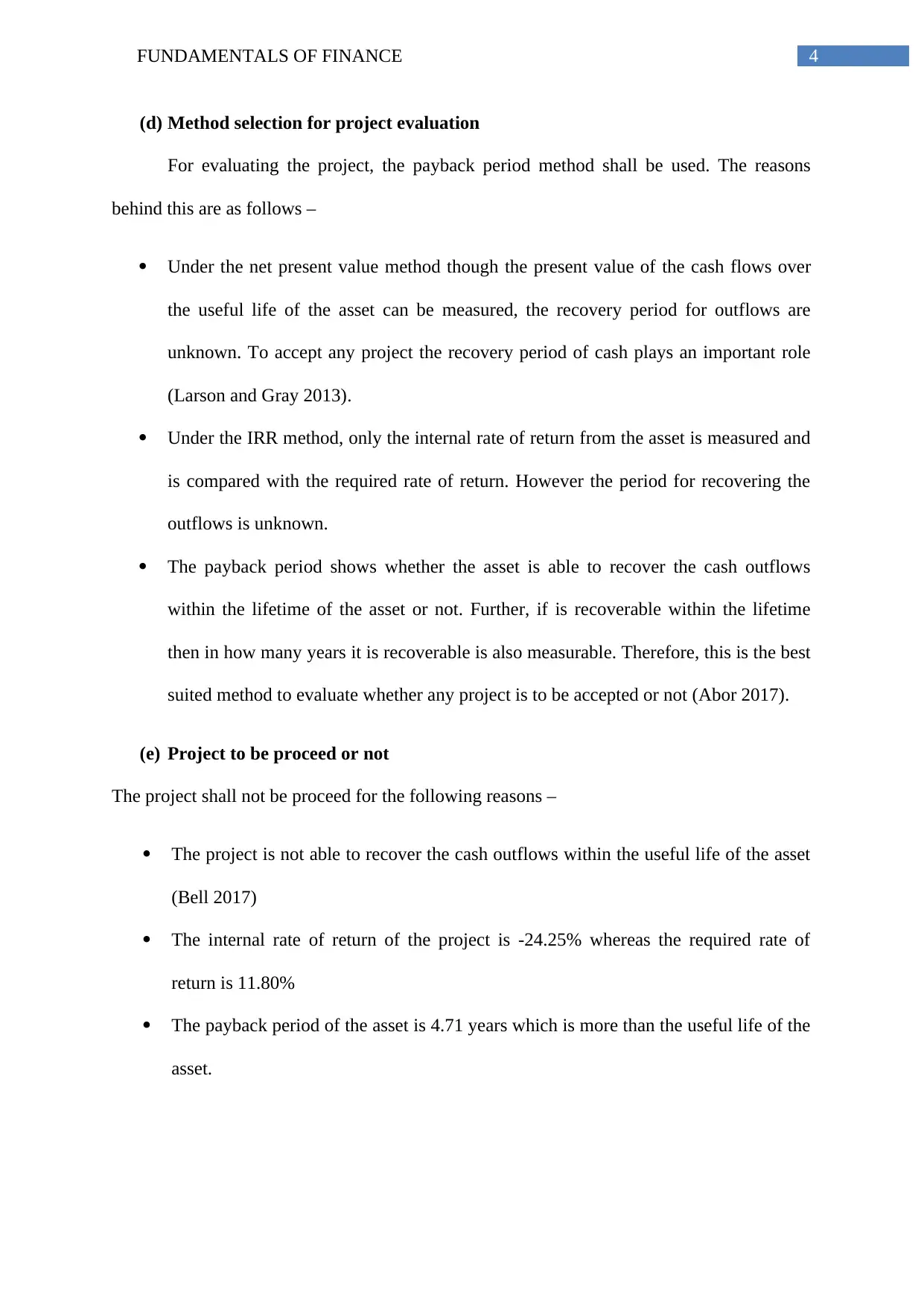
4FUNDAMENTALS OF FINANCE
(d) Method selection for project evaluation
For evaluating the project, the payback period method shall be used. The reasons
behind this are as follows –
Under the net present value method though the present value of the cash flows over
the useful life of the asset can be measured, the recovery period for outflows are
unknown. To accept any project the recovery period of cash plays an important role
(Larson and Gray 2013).
Under the IRR method, only the internal rate of return from the asset is measured and
is compared with the required rate of return. However the period for recovering the
outflows is unknown.
The payback period shows whether the asset is able to recover the cash outflows
within the lifetime of the asset or not. Further, if is recoverable within the lifetime
then in how many years it is recoverable is also measurable. Therefore, this is the best
suited method to evaluate whether any project is to be accepted or not (Abor 2017).
(e) Project to be proceed or not
The project shall not be proceed for the following reasons –
The project is not able to recover the cash outflows within the useful life of the asset
(Bell 2017)
The internal rate of return of the project is -24.25% whereas the required rate of
return is 11.80%
The payback period of the asset is 4.71 years which is more than the useful life of the
asset.
(d) Method selection for project evaluation
For evaluating the project, the payback period method shall be used. The reasons
behind this are as follows –
Under the net present value method though the present value of the cash flows over
the useful life of the asset can be measured, the recovery period for outflows are
unknown. To accept any project the recovery period of cash plays an important role
(Larson and Gray 2013).
Under the IRR method, only the internal rate of return from the asset is measured and
is compared with the required rate of return. However the period for recovering the
outflows is unknown.
The payback period shows whether the asset is able to recover the cash outflows
within the lifetime of the asset or not. Further, if is recoverable within the lifetime
then in how many years it is recoverable is also measurable. Therefore, this is the best
suited method to evaluate whether any project is to be accepted or not (Abor 2017).
(e) Project to be proceed or not
The project shall not be proceed for the following reasons –
The project is not able to recover the cash outflows within the useful life of the asset
(Bell 2017)
The internal rate of return of the project is -24.25% whereas the required rate of
return is 11.80%
The payback period of the asset is 4.71 years which is more than the useful life of the
asset.

5FUNDAMENTALS OF FINANCE

6FUNDAMENTALS OF FINANCE
Reference
Abor, J.Y., 2017. Evaluating Capital Investment Decisions: Capital Budgeting.
In Entrepreneurial Finance for MSMEs (pp. 293-320). Springer International Publishing.
Bell, P., 2017. Introducing the Net Present Value Profile.
Larson, E.W. and Gray, C., 2013. Project Management: The Managerial Process with MS
Project. McGraw-Hill.
Vernimmen, P., Le Fur, Y., Dallochio, M., Salvi, A. and Quiry, P., 2017. Investment
Criteria. Corporate Finance: Theory and Practice, Fifth Edition, Fifth Edition, pp.508-525.
Reference
Abor, J.Y., 2017. Evaluating Capital Investment Decisions: Capital Budgeting.
In Entrepreneurial Finance for MSMEs (pp. 293-320). Springer International Publishing.
Bell, P., 2017. Introducing the Net Present Value Profile.
Larson, E.W. and Gray, C., 2013. Project Management: The Managerial Process with MS
Project. McGraw-Hill.
Vernimmen, P., Le Fur, Y., Dallochio, M., Salvi, A. and Quiry, P., 2017. Investment
Criteria. Corporate Finance: Theory and Practice, Fifth Edition, Fifth Edition, pp.508-525.
1 out of 7
Related Documents
Your All-in-One AI-Powered Toolkit for Academic Success.
+13062052269
info@desklib.com
Available 24*7 on WhatsApp / Email
![[object Object]](/_next/static/media/star-bottom.7253800d.svg)
Unlock your academic potential
© 2024 | Zucol Services PVT LTD | All rights reserved.




